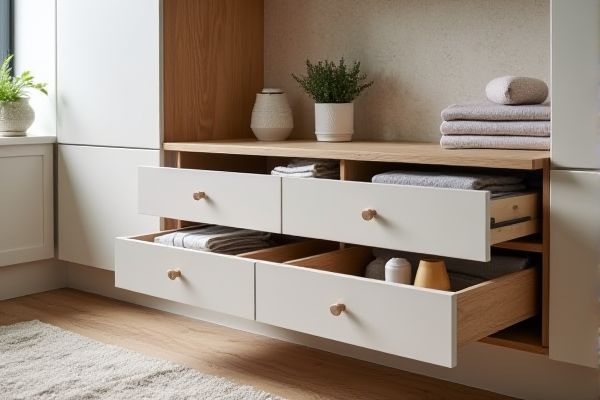
Floating drawers maximize under-cabinet space and create a modern, airy aesthetic, while built-in drawers offer seamless integration and enhanced durability within your cabinetry. Discover which drawer style best suits your storage needs and design preferences by reading the rest of the article.
Table of Comparison
| Feature | Floating Drawers | Built-in Drawers |
|---|---|---|
| Installation | Mounted on walls with brackets, no floor contact | Integrated into cabinetry structure, floor or wall mounted |
| Space Utilization | Creates open floor space, enhances room flow | Maximizes internal storage within cabinet footprint |
| Aesthetic | Modern, sleek, minimalist look | Traditional, seamless cabinet appearance |
| Weight Capacity | Typically lower load capacity due to wall support | Higher load capacity with solid cabinetry foundation |
| Maintenance & Cleaning | Easy cleaning under drawer, reduced dust accumulation | Cleaning limited to drawer and cabinet interior |
| Customization | Limited size and design options due to mounting | Highly customizable in size, depth, and design |
| Cost | Generally higher due to specialized mounting hardware | Usually cost-effective, integrated during cabinetry build |
| Common Uses | Modern bathrooms, contemporary kitchens, offices | Traditional kitchens, bedrooms, storage furniture |
Introduction to Floating Drawers and Built-in Drawers
Floating drawers offer a sleek, modern aesthetic by being mounted without visible supports, creating an illusion of space and enhancing room openness. Built-in drawers, integrated directly into cabinetry or furniture, provide robust storage solutions with seamless design continuity and structural stability. Understanding the differences between floating drawers and built-in drawers helps you choose the best option for your storage needs and interior style.
Design Aesthetics: Comparing Visual Impact
Floating drawers create a sleek, modern look by appearing to hover without visible supports, enhancing minimalist design aesthetics and adding a sense of spaciousness in your room. Built-in drawers offer a classic, seamless integration with cabinetry, providing a cohesive and sturdy visual impact that complements traditional or custom interiors. Choosing between floating and built-in drawers depends on whether you prioritize contemporary style with clean lines or timeless, unified design elements.
Installation Process: Complexity and Requirements
Floating drawers require precise wall mounting and reinforcement to support weight, often necessitating professional installation and structural assessment. Built-in drawers involve carpentry skills to integrate seamlessly within existing cabinetry or walls, requiring measuring, framing, and sometimes custom adjustments. Both options demand careful planning, but floating drawers typically present higher complexity due to load-bearing considerations and hardware selection.
Space Optimization: Which Maximizes Storage?
Floating drawers enhance space optimization by creating an illusion of openness and allowing easier cleaning underneath, but built-in drawers maximize storage capacity by utilizing the full depth and width of cabinetry without gaps. Built-in drawers often provide more organized compartments tailored to your needs, reducing wasted space and improving accessibility. Your choice depends on whether maximizing storage volume or maintaining a sleek, spacious appearance is the priority in your design.
Durability and Longevity of Both Options
Floating drawers, often made with high-quality plywood and metal brackets, offer excellent durability and resist warping over time, making them a long-lasting choice for modern interiors. Built-in drawers, integrated directly into cabinetry, provide superior structural stability and can last decades with proper maintenance due to their solid frame construction. Your decision should consider the environment and usage frequency, as floating drawers excel in lightweight applications while built-in drawers handle heavier loads and daily wear more effectively.
Cost Comparison: Upfront and Long-Term Expenses
Floating drawers generally have a higher upfront cost due to specialized installation and premium materials, while built-in drawers are often more affordable initially, especially with standard cabinetry. Over time, floating drawers may incur greater maintenance expenses due to their exposed hardware and structural complexity, whereas built-in drawers typically offer more durability and lower long-term repair costs. Your choice should factor in both immediate budget constraints and potential future spending on upkeep to ensure a cost-effective solution.
Flexibility and Customization Possibilities
Floating drawers offer superior flexibility by enabling easy relocation and customization without structural modifications, making them ideal for evolving storage needs. Built-in drawers provide seamless integration and durability but require precise initial measurements and limited adaptability once installed. Choosing between the two hinges on the balance between immediate customization and long-term permanence in storage solutions.
Maintenance and Cleaning Considerations
Floating drawers typically offer easier access for maintenance and cleaning due to their exposed undersides and gaps around the frame, allowing you to reach dust and debris without dismantling the unit. Built-in drawers, integrated seamlessly into cabinetry, often require more effort to clean as tight spaces and fixed panels can trap dirt and grime. Choosing floating drawers can simplify routine upkeep, especially in high-traffic areas where dust accumulation is frequent.
Best Use Cases: Where Each Drawer Excels
Floating drawers excel in modern, minimalist spaces where you want to maximize floor visibility and create an airy feel, making them ideal for small rooms or contemporary interiors. Built-in drawers are best suited for maximizing storage efficiency in traditional or custom cabinetry, perfect for kitchens, closets, and furniture where seamless integration and durability are priorities. Your choice depends on whether you prioritize sleek design and space-saving or robust, integrated storage solutions.
Conclusion: Choosing the Right Drawer for Your Space
Floating drawers offer a modern, sleek aesthetic and maximize floor space, making them ideal for smaller rooms or contemporary designs. Built-in drawers provide superior storage capacity and durability, seamlessly integrating with existing cabinetry for a cohesive look. Your choice depends on balancing style preferences, available space, and storage needs to create a functional and visually pleasing environment.
 homyna.com
homyna.com